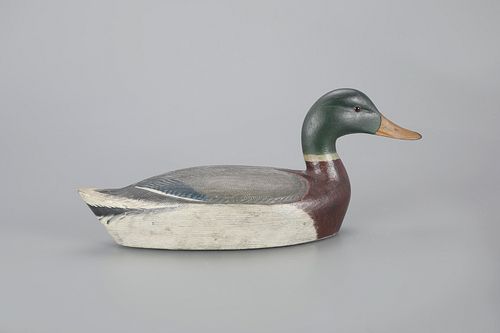Exceptional Mallard Drake Decoy by Chauncey "Chance" Wheeler (1888-1945)
Lot 177
About Seller
Copley Fine Art Auctions
20 Winter Street
Pembroke, MA 02359
United States
Founded in 2005, Copley Fine Art Auctions is a boutique auction house specializing in antique decoys and American, sporting, and wildlife paintings. Over the course of the last two decades, the firm has set auction records for not only individual decoy makers, but also entire carving regions. Copley...Read more
Estimate:
$50,000 - $70,000
Absentee vs Live bid
Two ways to bid:
- Leave a max absentee bid and the platform will bid on your behalf up to your maximum bid during the live auction.
- Bid live during the auction and your bids will be submitted real-time to the auctioneer.
Bid Increments
| Price | Bid Increment |
|---|---|
| $0 | $50 |
| $1,000 | $100 |
| $2,500 | $250 |
| $5,000 | $500 |
| $10,000 | $1,000 |
| $25,000 | $2,500 |
| $50,000 | $5,000 |
About Auction
By Copley Fine Art Auctions
Feb 24, 2023
Set Reminder
2023-02-24 10:00:00
2023-02-24 10:00:00
America/New_York
Bidsquare
Bidsquare : The Winter Sale 2023, Day 1
https://www.bidsquare.com/auctions/copley/the-winter-sale-2023-day-1-11939
Lots 1-337 Copley Fine Art Auctions cinnie@copleyart.com
Lots 1-337 Copley Fine Art Auctions cinnie@copleyart.com
- Lot Description
Exceptional Mallard Drake
Chauncey "Chance" Wheeler (1888-1945)
Alexandria Bay, NY, c. 1920
17 3/4 in. long
This highly refined mallard is understood by many to be not only the finest Chauncey Wheeler decoy, but also the best from the entire region. Beyond the region, it stands among the most important mallard drakes by any maker. Like some of A. Elmer Crowell's best carvings, it was rigged for use as a decoy, yet it shows the refinement and effort the maker exhibited in his best decorative works. The gouged detail is reminiscent of the flourishes seen in the most highly prized works of the Caines Brothers from South Carolina. A view from above this Wheeler carving shows the coveted "Heart Pattern"of the wings and back. The paint is deftly applied with combed, stippled, and wet-on-wet techniques on display.
While the mallard is an ubiquitous species in North America today, wild native mallards, and subsequently their decoys, were scarce in the East during Wheeler's era. This decoy is the finest of its kind; illustrating its rarity, only one other example is remotely comparable. The other bird is illustrated and discussed in the 2002 monograph on "Chance"in a dedicated chapter titled "New Found Species and Style."This lot was widely unknown until its public offering in 2012, when it set the record for any Wheeler decoy or decorative. Since then it has been toured and illustrated broadly. The underside retains Kirson Collection markings and a Ward Museum exhibition label.
Original paint with light wear.
Provenance: Robert Billingsly
Private Collection, New York
Donald Kirson Collection
Literature: "The Year in Review 2012,"Decoy Magazine, 2012, front cover, exact decoy illustrated. "48th annual Decoy & Wildlife Art Show,"Decoy Magazine, 2012, July/August 2016, p. 19, exact decoy illustrated. "Decoy Magazine,"March/April 2019, p. 19, exact decoy illustrated.Please email condition report requests to colin@copleyart.com. Any condition statement given is a courtesy to customers, Copley will not be held responsible for any errors or omissions. The absence of a condition statement does not imply that the lot is in perfect condition.Condition
- Shipping Info
-
Shipping info
Copley does not offer in-house packing or shipping. For clients who require shipping, please complete the Shipping Release Form and return it with your payment. The form includes a list of shippers we frequently work with.
-
- Buyer's Premium



 EUR
EUR CAD
CAD AUD
AUD GBP
GBP MXN
MXN HKD
HKD CNY
CNY MYR
MYR SEK
SEK SGD
SGD CHF
CHF THB
THB
















